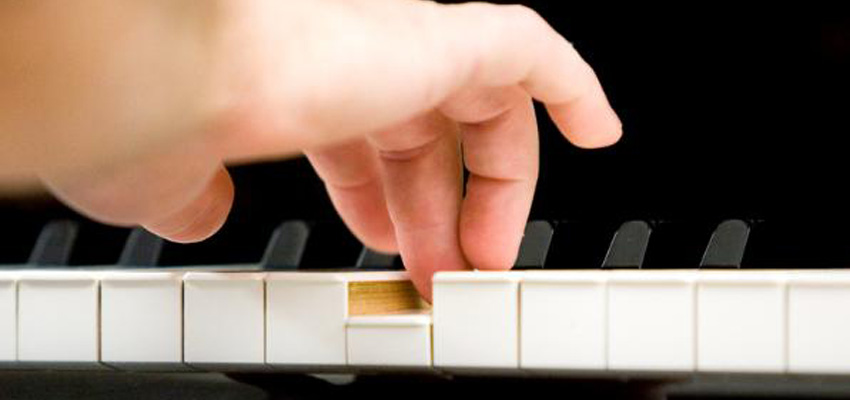
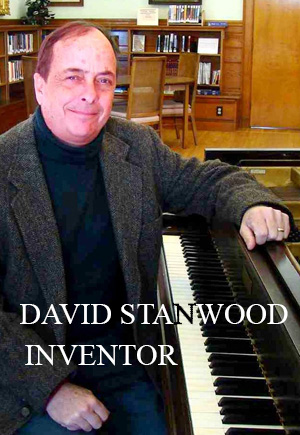 I was speaking with someone recently about this blog post on touch, describing it as “an interview with a piano mathematician”.
I was speaking with someone recently about this blog post on touch, describing it as “an interview with a piano mathematician”.
“There are piano mathematicians?” was the reply. If people only knew how many calculations go into the engineering of a single instrument, they would be astounded.
Today we have the privilege of speaking with David Stanwood, a piano technician who also happens to be a published author specializing in piano touch metrology. (Metrology being the science of measurement). He has spent decades studying, pouring over data to understand what it is that we FEEL under our fingers at the piano ~ what it is that makes the piano satisfying to play. The only problem is, it’s a little like speaking with a Formula One mechanic and asking “how does the car work?” It’s difficult to take these highly complex calculations and make them easily understandable. So what we’re going to attempt to do is start with the basics and work our way forward through some of the more complex questions. I hope you will find this not only interesting but also challenge your thinking about how we approach piano playing, performance and the technical angles of piano touch.
Glen Barkman:In its simplest form, can you define what touch is?
David Stanwood: Touch is the tactile connection between musical intention and piano tone.
GB: Musical intention. I’ve never really thought about it but you’re right, before we play, we make decisions, we pre-determine what sound we want to come out of the instrument that sits in front of us. When we touch the keys, that tactile connection is the bridge between what we seek and the tone we desire.
GB: In your opinion, what constitutes a satisfying piano touch?
DS: A piano with satisfying touch gives the pianist comfortable control of tone across the keyboard and at all dynamic levels (from pianissimo to fortissimo).
GB: From beginner piano students all the way to concert pianists, why is the concept of touch so important?
DS: Pianists use technique to control their sound and play expressively. It takes different techniques to play on pianos that have a light, medium, or heavy touch. A beginner is less flexible in their ability to adjust to different piano types because they are more limited in their technical skills. It’s best for a beginner to play on a piano that feels comfortable with a sound that they connect with emotionally. The professional pianist has more extensive ear training and a repertoire of technique that allows them to adapt more easily to the variety pianos they perform on.
GB: The piano, due to its immense size and weight is one of the few instruments musicians don’t readily carry with them. A violinist or horn player will show up to a performance and have full knowledge of what to expect from their own instrument. Pianists need to adapt to a variety of levels of touch. It’s a requirement of the instrument.
DS: Yes and pianists also expect and want a predictable response from every note. If one plays a scale at any dynamic level, it should take the same touch applied to each key. This simply makes it easier to control the sound. Unfortunately, there are lots of pianos with uneven touch. It takes highly skilled technique to play on a piano with uneven touch and without that level of skill the results are less expressive and not as satisfying.
Rosalyn Tureck talks very clearly about the challenge of performing on pianos with uneven touch in Steinway’s informative booklet “Talking About Pianos” Published in 1982:

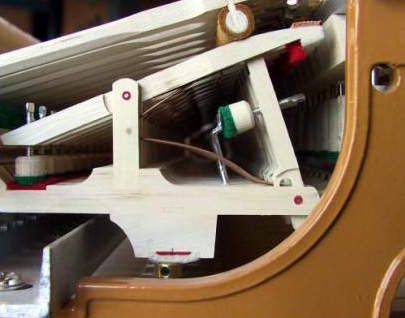 GB: Many have not seen the inside of a piano. In basic terms, what’s the purpose of the levers that make up the piano keys and action?
GB: Many have not seen the inside of a piano. In basic terms, what’s the purpose of the levers that make up the piano keys and action?
DS: There are three functions of the piano action:
1. Multiplying force: The levers in each piano key make the hammer go up much faster than the key goes down. This multiplying effect gives the hammer enough velocity to produce sufficient tone.
2. Escapement: The second purpose of the action design allows the hammer to release from the pushing force of the mechanism just before hitting the string without jamming the hammer against the string.
3. Repetition: The action makes it possible for the pianist to be able to repeat the playing of each note quickly.
GB: How has piano touch evolved over the centuries?
DS: Chopin played and composed on mid 19th century pianos that had, very soft, light hammers, and a very light and shallow touch. The piano evolved into it’s final structural form in the late 19th century to have heavier hammers with heavier and deeper touch than its antique predecessor. Over the course of the 20th century we see hammer weights evolving even higher and tapping into the hidden tonal potential that we find in today’s pianos. To keep actions from becoming too heavy, the pivot point of the keys (balance rail) on today’s pianos is a little farther back than it was 100 years ago. This means the hammers do not move up quite as fast in relation to the key going down. As a result, the touch of today’s pianos is about 1mm deeper than those made earlier in the 20th century, bottoming out at a depth or “Dip” of 10.5mm. We find wide variations in touch of pianos at any point in history.
GB: You wouldn’t think that 1 millimeter of touch depth would make a difference but it is quite noticeable at the keyboard. Similarly our sense of touch is quite acute even in how level keys are or even variation in key resistance from one piano to another or from key to key.
Before going any further, take a moment to watch this brief video from David Stanwood where you’ll be able to see more of what is involved with Precision Touch Design:
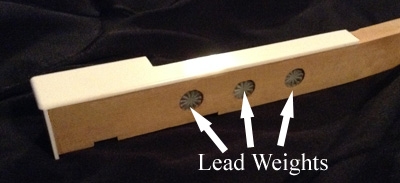 GB: To aid the feel of the key, lead weights were introduced over a century ago and inserted into the keys. So manipulation of weight has been around for years now. What’s the purpose of the lead weights?
GB: To aid the feel of the key, lead weights were introduced over a century ago and inserted into the keys. So manipulation of weight has been around for years now. What’s the purpose of the lead weights?
DS: Leads are traditionally set in the key to make it just barely drop with a 50g downweight (the weight required to start to move the key down). Hammers are heavier in the bass and lighter in the treble so there is more lead weight in the bass side of the piano and less on the treble side. Intuitively we think that making a perfectly consistent down weight will make piano feel perfect but it is an illusion. The inconvenient truth is that down weight is a very poor indicator of the forces that the pianist uses when playing at different volume levels. This is because down weight is measured with the key moving so slowly that the hammer does not go fast enough to hit the string. At playing speeds, the laws of inertia apply and the pianist experiences much higher playing forces which we refer to to as “Dynamic Touch”. Down Weight could be called “Static Touch”. It’s easy to measure but has little to do with playing pianos and making music.
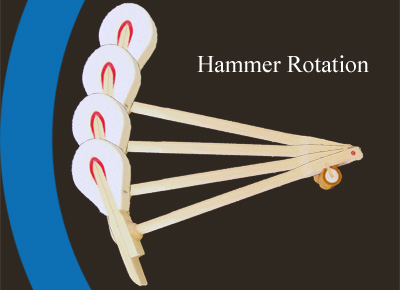 GB: How then do you approach the piano to make this dynamic touch (from extremities of soft to loud playing)?
GB: How then do you approach the piano to make this dynamic touch (from extremities of soft to loud playing)?
DS: My approach is to look at the component structure of Dynamic Touch. To do this I had to invent a whole new realm of piano science. It’s called “Touch Weight Metrology”. I developed new protocols which include Strike Weight – the weight of the mounted hammer and Front Weight – the amount of counterbalancing weight in each key. What ties it all together is the “Equation of Balance” which I discovered in the mid 1990’s. With the equation it became possible to calculate the amount of weight it takes to balance a gram of hammer weight. It’s called the Strike Weight Ratio which relates to how fast the hammer moves in relation to the key. Up until that time it was generally assumed that all action ratios were 1:5. GB: Meaning that for the force of the key was multiplied five fold at the hammer? DS: Yes, and to our surprise it turned out that the ratio could be anywhere from 5 to 7 depending on the age of the piano and its construction quirks. We studied hundreds of pianos and found that specific hammer weight/ratio combinations are associated with specific dynamic touch types. The key component of dynamic touch is the weight of the hammer. This little mass of wool felt covered wood is what transfers the energy of the finger’s stroke into glorious tone emanating from the soundboard. The hammer produces 70% – 90% of the force that the pianist exerts on the key when playing. Studies show that inconsistencies in hammer weights are the major factor in contributing to inconsistent dynamic touch. Smooth out the hammer weights and you smooth out the dynamic touch.
It’s not a silver bullet but it is a powerful tool.
As for our old friends the key weights – they will always have a place in piano construction. And down weight? – It plays a part but relates mainly to the pianissimo side of playing.
GB: And now for the ever-so-popular question… Can the touch of a piano be changed and improved? And what is the process for changing the feel of a piano?
DS: The touch of any piano even those of the highest quality can be changed and improved. The approach I take is to first perform a touch weight component analysis. I carefully listen to the client talk about their needs and desires. I inspect the action, I listen carefully to the piano and I play it myself. From all this data, a clear choice of engineered solutions emerges. These alway include smoothing out the Strike Weights and adjusting the level of Strike Weights to be higher or lower and most importantly to be a match for ratio.
GB: So for clarification, if I can interject, what you’re saying is that the smoothing out of strike weights refers to adjusting the weights mainly in the piano hammers because the leverage in the action makes every gram count when it is multiplied?
DS: Yes , actually every tenth of a gram counts. That’s why it is so important to pay attention to hammer weight. This skill has been overlooked in the evolution of piano technology. If the ratio is out of bounds, we adjust the position of lever points within the action to create a match. The weights in each key are always attended to as well because the traditional down weight balancing method that all piano makers have been using always produces inconsistencies in the key weights. I use the equation to calculate perfect key balancing patterns for remounting and fine tuning the counterbalancing weights within each key. The regulation of the action attending to friction
tuning and voicing of the piano are addressed as well.
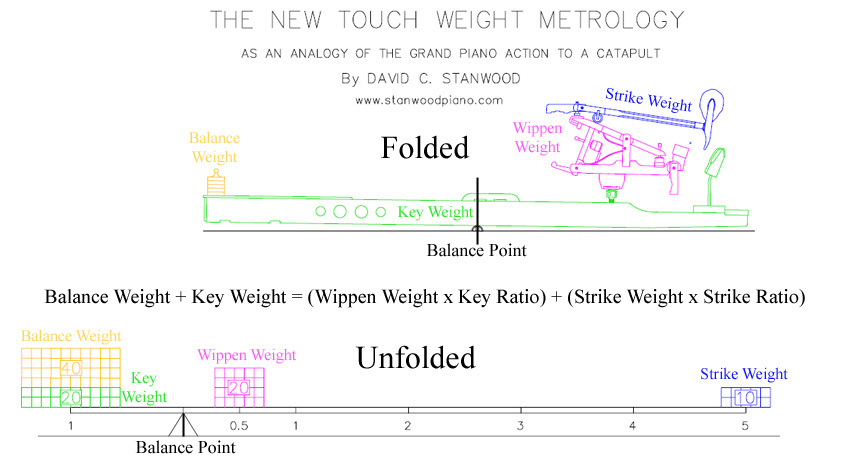
GB: After years of analysis, you came up with an algebraic equation to explain piano touch. Can you briefly share the concept and the idea behind this “folded” and “unfolded” beam method of thinking about your Equation of Balance?
DS: It’s not rocket science, it’s see-saw science. The piano action seems like a complicated mechanism but it is actually what engineers call a Folded Beam which is to say it’s design, with key, wippen, and hammer shank, is made into a compact and practical mechanism. To understand the weight, leverage, and friction relationships in a piano key, it’s helpful to use the direct analogy of the key as a see-saw with a short side which represents the playing side of the key with a weight on its end representing the key weights. On the other side, the hammer sits way out on the long end. One may easily see that when one moves the short end down slowly, the long end moves up quickly just like a piano key. The ratio is represented as how far out the hammer sits. It’s easy to imagine that adding or subtracting weight to the hammer or sliding it in our out on the long end is going to have a big impact on how much weight it takes to balance at the short end. The wippen is represented by a weight just behind the fulcrum. Friction is represented by a rusty bearing on the pivot point.
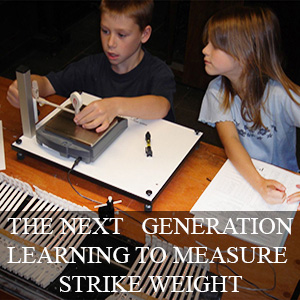 Thinking this way makes the relationships clear. I’ve even used the see-saw to show 5th graders how a balanced beam with weights on both sides is equivalent as an algebraic expression with an equal sign. You could see the light bulbs going off by the expression in their faces!
Thinking this way makes the relationships clear. I’ve even used the see-saw to show 5th graders how a balanced beam with weights on both sides is equivalent as an algebraic expression with an equal sign. You could see the light bulbs going off by the expression in their faces!
GB: What we’re looking at above is a cutaway of a grand piano key. Pictured is the side profile. The orange colored weights represent the necessary weight (which would in effect be our fingers pressing down the key) to balance the equation. The second diagram depicts those same ideas spread out. The numbers along the see-saw are the multiplying effects of those same levers. The picture here has a 5 to 1 ratio meaning that every gram at the hammer is multiplied by 5 at the keyboard, thus as you mentioned before, the importance of smoothing out the weights of the hammers. Though it looks like 5th grade math and paradoxically simple, when you add in the fact that the hammer is on a rotational axis and then you add in lead weights with friction points, the puzzle becomes more challenging.
GB: Historically, lead weights are the usual go-to for balancing a piano action. But talk to us about strike weight and what impact hammer weight balancing is can have on the piano.
DS: Historically lead weights have been used to hide a host of sins. For example if a key bushing is too tight when keys are balanced, more lead is typically put into the key to get it to go down. When the key loosens up after playing, the extra lead weight in that one key will make it respond differently from its neighbors and making the dynamic touch uneven. Or if a hammer is cut a little wider making it heavier than its neighbors, more lead is put into the key. In this case the uneven hammer weight makes dynamic touch uneven and the effect is magnified even more by the uneven lead weights in the key. Better to fix the friction or hammer weight rather than throwing lead weight at the problems.
My approach is to design and make dynamic touch by building touch weight components to precise engineered specifications. Most importantly strike weight is matched with the action ratio. This sets the stage for the dynamic quality of the action. Once the strike weight and action ratio is known the key weighting specifications for each key are calculated using the equation of balance.
The dynamic touch design is then installed to specification by individually adding or subtracting the strike weight of each hammer so they are perfectly consistent from note to note. Similarly lead weights in the keys are individually set into the side of the keys using precise specifications all installed to within a few tenths of a gram. This results in a specific dynamic touch quality that is perfectly consistent and predictable from key to key when played.
With these “Equation Balanced” actions the key weights are truly set permanently in the right place and never have to be altered again. When hammers wear out down the road, the new hammers are made to the touch design specifications and the integrity of balance may be maintained for the life of the instrument.
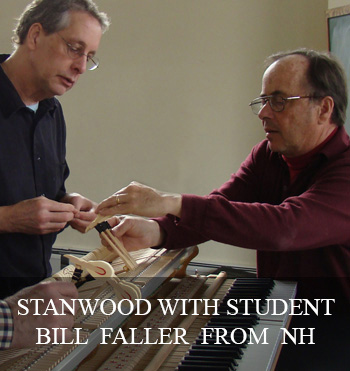 GB: So to recap then, pianos have been measured from the front (meaning the key and lead weights). What you’re saying is that we need to start thinking from the hammer and working backwards. We need to look more closely at Strike Weights and Strike Ratio. Since lead weights will really only affect a small fraction of the representative touch, addressing the Strike Weight will affect all levels of dynamics and not just quiet playing.
GB: So to recap then, pianos have been measured from the front (meaning the key and lead weights). What you’re saying is that we need to start thinking from the hammer and working backwards. We need to look more closely at Strike Weights and Strike Ratio. Since lead weights will really only affect a small fraction of the representative touch, addressing the Strike Weight will affect all levels of dynamics and not just quiet playing.
DS: Yes and so this vision for the piano industry includes training piano technicians on hammer weight balancing skills. They have to learn how to work with a hammer/strike weight specifications and be skilled in reducing weight by cutting and/or sanding the sides of the hammers, or increasing hammer weight, swaging small bits of lead weight into the wooden molding of the hammer. I’ve been balancing strike weights since the mid 1990’s. Initially there was some push back but now after 2 decades of teaching and training it has become an accepted method for technicians aspiring to the highest quality in their work.
GB: The evolution of the piano has led to this point of now being able to represent touch as an algabraic expression. Thanks, David for your efforts in all of this. I started reading your works back in about year 2000 and was amazed (back then and even more today) at your abilities to calculate touch.

GB: It has been great talking with you. Be sure to stop in at David Stanwood’s Website and look at many of the resources there. He has developed Precision Touch Design and offers training and courses to technicians globally.
More Piano Articles

During the performance of Jacob Collier at the most recent NAMM show I was reminded that music makes us human, that beauty binds us together as a collective, and that the reason the music industry exists is to aid in the creation of art. I needed that reminder without which, the annual trade show featuring many of the great piano makers is just the sale of wares. I believe that people are feeling the uncertainty ...
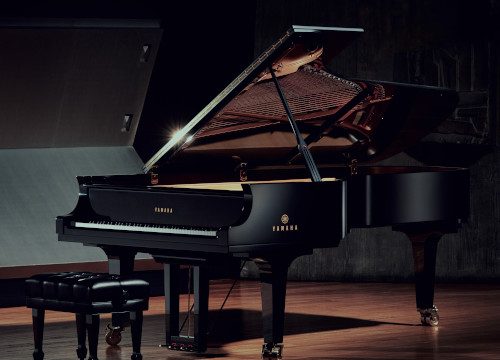
I used to have a teacher who would frequently say, “For every single grade point PAST 80%, it takes as much effort as the FIRST 80.” I believe this statement to be true from experience. The first 80 is the easiest. Chipping away at every point past that is the challenge. The bulk of the work can bring a project into shape but it’s the pursuit of excellence, that’s where the challenge lies. Yamaha is ...

The value of a piano is obvious ~ it’s the music that you make with it. But often, families are going through life changes which involve a house move and unfortunately, the piano needs to be sold. They invariably ask the question, “What are we going to do about the piano?” This question comes up because, as you can imagine, they’re not easy to move. We don’t simply pack them away in a cardboard box ...

You’ve been playing your piano for years now and the time has come to seriously consider downsizing the house and move into a condo. But what do you do with the piano? You love your piano and can’t imagine life without it and besides, you absolutely hate the idea of playing a digital keyboard. Many people don’t know that you can add digital functionality without compromising your existing piano. Yes, it is completely possible to ...
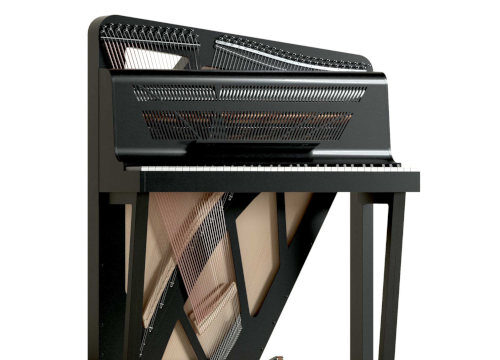
Many years ago, I remember seeing a piano in a museum similar to the one shown above (built in 1787 by Christian Gottlob Hubert. On display at Germanisches Nationalmuseum - Nuremberg, Germany). I have often wondered why acoustic portable pianos never really took off. Although we've seen more portable keyboard instruments like harpsichords, accordions or electronic keyboards, they operate completely different from a traditional piano in that they either pluck the strings, use air with ...
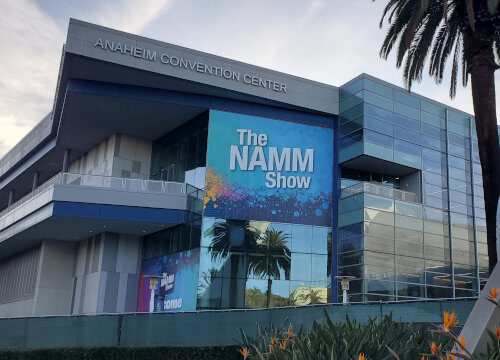
This was the first year since covid that the National Association of Music Merchants (NAMM) trade show was back to its regular January date and, in fact the first show where it felt back to normal. How was it? To answer that, I'm going quickly review the piano market over the last few years. Piano sales boomed during covid. Think about it - everyone was at home and with time on their hands, many turned ...